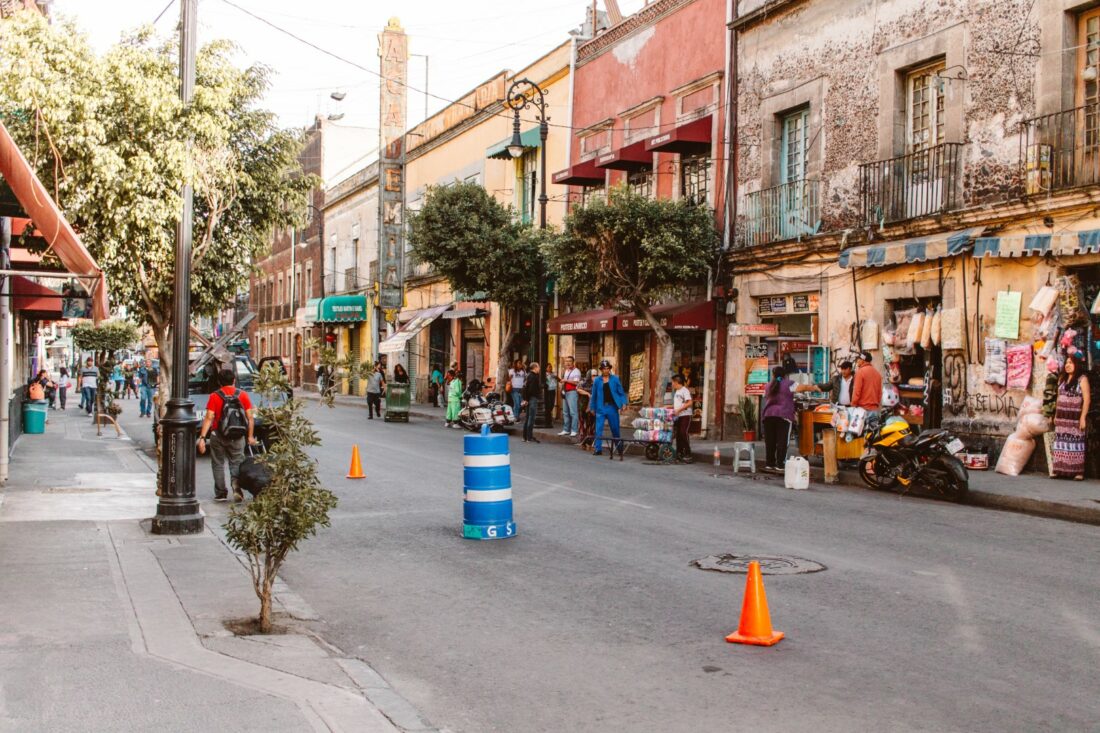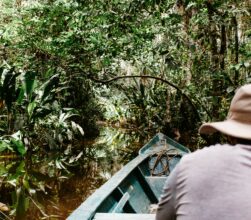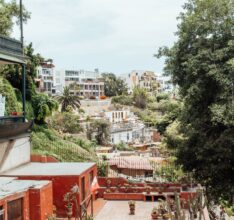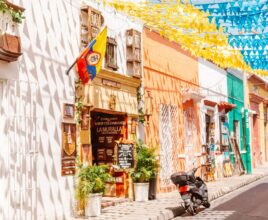We got in to our room in the Centro district of Mexico City a little shook up from turbulence and exhausted from our early flight. Despite the grogginess, we were immediately struck by the vibrance and liveliness of the city. The streets were packed with cars and motorcycles, and the sidewalks were packed with people, food carts, and shops.
I was totally unprepared for the sheer scale of the city. It’s the 4th largest in the world, with a metro area containing over 20 million people. It sprawls for miles in every direction. So many people bring an incredible feeling of life to this beautiful, historic, delicious, deeply cultural city.
Mexico City was a great way to start our travels – we ate amazing food, had adventures, and got a taste of what it means to be self-sufficient abroad. We had plenty of good times, and just a few challenges.
What did we eat?
So many things! Especially tacos! Because this post is really long already, I broke out all the food into its own post.
What did we do?
With a stay of a week, we had plenty of time to explore some of the best sights around Mexico City at our leisure. Even with that much time, we still left a few things, like a trip to Puebla, for our next visit.

Museo Nacional de Antropología
One of our first stops was the world-renound archaeology museum in the enormous park district of Chapultepec. We took the Metrobus from outside the Palacio de Bellas Artes to get there.

The first thing we saw was a quintet of figures in traditional Mayan outfits gracefully spinning down head-first from a thirty-foot pole, accompanied by drums and pipes from a figure at the top of the pole. We later learned that this was the Danza de los Voladores, an ancient Mesoamerican ritual still practiced today.
After a quick lunch, we headed inside. The museum is enormous, containing some twenty-two exhibitions of Mesoamerican history, archaeology, and anthropology. We learned about the major and minor civilizations of pre-colonial Mexico and Central America. By far the best exhibits were the ones dedicated to the people of Teotihuacán, the Aztecs, and the Mayans – the largest Mesoamerican civilizations.
We saw their stunning architecture, learned about their religion and rituals, and got a chance to see their sculpture, pottery, weapons, and other instruments of daily life.
My particular favorite was seeing all the fun little figurines. They really added a sense of playfulness and joy in between the serious religious iconography and enormous and intricately carved statuary. You can see that people from hundreds and thousands of years ago loved silly and cute things as much as we do!

Teotihuacán
Teotihuacán is an ancient city that has been preserved and restored. Founded around 300 BC, it served as home to a number of different civilizations, until its downfall and destruction in 750 AD. Its ruins are about an hour and a half northeast of Mexico City. We got there by bus, and I really enjoyed seeing the change in landscape as we got out of the city. Some of the suburbs looked like a great change from the sometimes cramped and crowded interior of the city. Eventually they fell away to scrubland, dotted with small trees and cactus.

The ruins themselves were powerful – the bones of ancient houses, gathering places, and religious buildings. The crown jewels of the site are the restored Temple of the Sun and Temple of the Moon. Each one has steep steps leading up to it, and a spectacular view of the ruins and the surrounding region from the top.
The people of Teotihuacán were excellent astronomers, and we learned a little bit about how they used the two temples to conduct different rituals the day before, in the museum of anthropology. If you come to the area, I’d definitely visit the sites in that order. It’s great to learn more about the ruins and the people behind them before you go.
If you’re in the mood to explore more, there’s plenty to do in the nearby town and countryside. There’s traditional obsidian-crafting, a staple export of the ancient city, as well as wood carving and mezcal production. Just remember to wear sunscreen and bring a hat – it’s quite flat and there’s almost no shade.


Coyoacán
Coyocán is a neighborhood in the southern part of the city. Full of trees and parks, it’s a wonderful place to relax and enjoy the culture of Mexico City at a slower and calmer pace. When we arrived, I was struck by how much it reminded me of a small college town – full of art, coffee shops, and places to sit and chat.
We went to our favorite coffee shop in the city there, where we sipped on espresso, ate donuts, and people watched.
One of the most popular activities in Coyocán is to visit the Frieda Kahlo museum at her house on the northern edge of the neighborhood. Unfortunately, we were not able to get tickets. We were stunned by the lenght of the line. So many people were waiting in the hot sun to see her incredible art!
We got to see some great pieces in the handicrafts market, as well as well as the art market on display in the park across from the mercado.

Mercado de Coyoacan was stunning – definitely our favorite one of the four that we saw. Packed full of fruits, vegetables, meat and fish, herbs, spices, and flowers, it is undoubtedly one of the defining features of daily life in the city. A farmer’s market in the states just pales in comparison to the incredible quality of food and goods available in any one of the mercados we saw.

Cooking Class
One of our goals for the trip is to take a cooking class in every country we land in. We love to cook (and eat!) and we figured this would be a great (and relatively inexpensive) way to experience local culture and cuisine. We found Nicole and Ricardo’s market tour and class on Cookly, which included a tour of Jamica (Hibiscus) Mercado and preparation of four local dishes of our choice.

Jamica Mercado was a great tour. It’s one of two flower markets in the city, known for being open twenty-four hours a day (midnight funerals, last minute weddings, and drunken seranades). As you can imagine, it’s gorgeous and smells divine. It’s also got what you’d expect from a classic mercado – groceries, food, and handicrafts. We picked up the ingredients for our meal and headed to Nicole and Ricardo’s home.
There we prepared a traditional chicken mole, chalupitas with cactus salad – a traditional pre-Colombian dish, and piña atole – a corn and pineapple drink. For dessert, we had corn fritters with sugar and cinamon.
Learning how to make mole from scratch was fascinating. The recipe we used, from Nicole’s grandma, contained fried bread, tortillas, several types of boiled chiles, tomatillos, spices, and more. It was absolutely incredible, maybe our favorite food of the trip. We’re so thankful to Ricardo and Nicole for showing us the market, inviting us to their home, and teaching us all about Mexican cooking, history, and their lives.


Mercado de San Juan
While not as visually impressive or diverse as some of the other mercados we went to, this market was definitely the most unique. At Mercado de San Juan, there are a huge number of exotic foods on display.
The more than 500 varieties of edible insect in Central America were an important part of the pre-Colombian diet, serving as both protein source and tasty snack. The tradition has survived to this day. Chalupines (grasshoppers) are a common snack and salsa base all around the city, but at Mercado San Juan, you can find worms, beetles, stinkbugs, and even scorpions!
At other stalls in the market, you could find rabbit, kid (baby goat, tsk!), and even a stall selling lion and zebra burgers. The other specialty of the market was tapas – tasty baguettes and foccacia covered in sliced meats and cheeses, olive oil, and rosemary. I also enjoyed the chalupín salsa, but that part was optional.
Fun tidbits
There were so many stand-out little moments during our week there that really set the culture of Mexico apart from anything I was expecting. Here’s a short list of some of the things that made the city feel unique.
There are dogs everywhere. It’s not unusual to see someone walking two, three, or four at a time down any given street. They’re definitely the favored pet of the area – we saw dozens and dozens of dogs but only a couple of cats.
There’s little break-out sessions of salsa and other dancing on many popular street corners. We saw people dancing to classic rock, reggeton, and classical music. It was also pretty common to get swarmed by a mariachi band while eating at a restaurant, or to have musicians board and play a few songs on the bus.
Mexican milk, butter, and especially crema are way richer and more delicious than what we get in the states.
There are police everywhere. Far from being intimidating, this makes the city feel really safe. You’re almost always in shouting distance of an officer, even in some of the more run-down neighborhoods we went to. That said, locals would warn us away from taking certain routes home or going to certain neighborhoods so you still need to be careful.

Escamole, or “aztec caviar” is the eggs of certain types of ants. We got a bite at Pujol – they were creamy, savory, and delicious.
If you’re looking for a place to stay in Mexico City, stay away from the Centro. It’s the biggest tourist destination, which makes it louder and more crowded than most of the rest of the city (and that’s saying something!) It also has worse traffic, which makes it difficult to get to the better food and entertainment districts. I’d recommend staying near Juarez or Roma instead.
Saturday is absolutely nuts – it’s the day everyone goes out on the town, so the streets are just clogged with people and vendors. It’s a real hoot, but can be a bit overwhelming. Pick your destinations with care on Saturdays!
In Mexico City, people of all ages are quite amorous. It’s really common to see couples making out nearly anywhere you go.

There is one of the most impressive post offices in the world here. We visited the Palacio Postal to drop off some post cards. It’s all gold trim, gilt, and marble, with enormous metal cages housing the tellers. Really impressive!
The Tough Stuff
It would be silly to expect that everything would go flawlessly our first week. There were some challenges to our stay in Mexico City. Nothing too serious, but good to keep in mind if you’re planning a visit.
First and foremost, pollution in the city is really bad. The city is absolutely enormous, and despite a decently well maintained metro system most people get around by car or bus. The smog from over 20 million inhabitants makes just being outside a challenge. We felt like the fumes were aggravating our skin and making it tough to breathe in popular areas.
The city is also at roughly 7500 feet above sea level, which was enough to give me some symptoms of mild altitude sickness for the first couple of days. I adjusted, but it’s a freaky feeling if you havn’t experienced it before. Expect shortness of breath and lightheadedness with exercise.
It’s also worth mentioning that the water in Mexico City is not potable. You can’t drink it from the tap, and you should use anti-microbial drops on any fresh leafy green (like lettuce or cilantro). It’s tough to avoid it everywhere, and we decided to be a little more lenient so we could enjoy iced beverages and salsa from taco carts without being too paranoid.
That said, we did have mild indigestion through most of our time there. It didn’t degenerate into full-blown Montezuma’s Revenge (traveler’s diarrhea), but between the spicy, greasy food and questionable water we rarely had fully settled stomachs.
Finally, and this is more a “me” thing than an “everyone” thing, I opted to buy a couple pairs of Bluffworks Ascender Chinos. I absolutely love these pants – they look good, have a nice stretchy fit, and have sensible zip pockets for keeping your stuff safe. They’re also made of 100% polyester.
This wouldn’t be a big deal, but I unfortunately learned that the bacteria in certain people’s sweat loves polyester. This means I need to be really careful when wearing these pants while it’s hot or I risk being one smelly hombre! Luckily, they’re quite easy to wash, which quickly solves the problem, but I suspect I’ll need to replace them for our hike up the Inca Trail.
Stinky pants aside, it’s been a wonderful week in Mexico City and we’re so lucky to have gotten the opportunity to visit. I’ve got a fresh appreciation for the depth of history and culture in Mesoamerica, for the beauty of the city, the kindness of its people, and the wonders of Mexican cuisine. We did a lot this week, but there’s still so much more we could have done, seen, and eaten.
Adios, Ciudad de Mexico!























